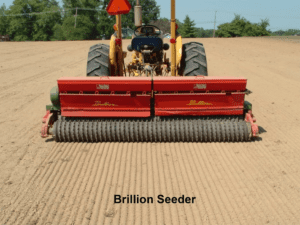By Dr. Don Miller
Director of Product Development | Alforex Seeds
along with Jeff Shaner, AgVenture Alfalfa Manager
This is the third entry in our 4-part series on alfalfa stand establishment, featuring the insights of Dr. Don Miller of Alforex Seeds. Here we delve into product selection and actual seeding of the crop.
Seed Treatments
Most if not all alfalfa seed is sold pre inoculated with beneficial nitrogen-fixing bacteria. Additionally, a variety of seed treatments are available that can enhance seeding survival during establishment. Coated seed with these additives included is becoming more popular and is generally less expensive per pound than raw seed. Despite having fewer seeds per bag due to the 33% coating, the enhanced seedling survival of coated seed when planted pound-to-pound provides stands comparable with uncoated seed. If coated seed is used, be sure to monitor your seeding rate while planting.
Timing of Planting
Alfalfa can be planted in the spring or fall. However, the preference for fall or spring plantings may be influenced by moisture and/or the ability to work the ground in a timely manner before planting. Don’t rush, plant when you can get a proper seedbed and soil temperatures are around 65 degrees.
Variety Selection
Select a variety with the appropriate Fall Dormancy (FD) and Winter Survival Rating (WSR) for your location and technology traits to fit and maximize your forage needs. Make sure your variety has adequate pest resistance levels (R or HR) for the major pests in your area.
Planting Rate
Seed is your lowest input cost, so plant enough seed (15-20 lbs/acre) to make sure you have a top-notch initial stand. Thin stands are very difficult to thicken up later in the season.
Seed Depth
The optimal planting depth for alfalfa is 1/4 – 1/2 inch. One of the most common causes of a poor initial stand is that the seed was not at the proper planting depth. Most failures are the result of the seed not being planted in a firm seedbed and placing the seed too deep for proper emergence. Check the seed depth several times after you start planting a field.
Planting Equipment
A wide range of planters can be used to plant alfalfa successfully, including grain drills, precision drills, Brillion packer types, airflow spreaders, and no-till drills. If you are planting in rows be sure to use the planter press wheels for good soil to seed contact, and keep the spacing relatively narrow to discourage weed competition. Broadcast plantings may need to be rolled/packed before and after planting to provide better seed to soil contact. The key to a successful stand, regardless of the planting method, is seed placement in a firm seedbed with good seed to soil contact.
Your AgVenture alfalfa seed selection comes with some details you need built right into the brand name. For instance, let’s look closer at AV42C20™. The first 2 digits in the name represent the general Fall Dormancy and Winterhardiness ratings. This product is a Fall Dormancy 4 with a strong Winterhardiness rating of 1.7 (rounded up = 2). The “C” in the middle demonstrates that this is a conventionally bred variety. The last 2 digits give the year of release. AV42C20 was new in the marketplace in 2020.
Next week we wrap up with Part 4. Come on back for our finale!
If you are ready to create an alfalfa plan for your operation, reach out to your AgVenture Yield Specialist or use the Seed Finder on our website to find your local Independent Seed Company.
